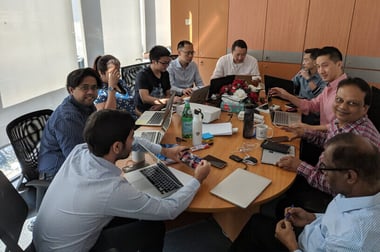The Philippines is one of the largest and fastest-growing economies in Southeast Asia. Its relatively young population and broad mobile network penetration have boosted the country’s internet-based businesses. About 20 million Filipinos also use e-wallets, which is quite significant considering the country’s population of over 100 million. Due to the approximately 79 million mobile phone users in the nation, e-wallets are also becoming quite popular among citizens. This is due to the ownership of two of the top digital wallet companies in the nation, Maya and Gcash, by the two main SIM card companies, Smart Communications and Globe Telecommunications, respectively.
52% of Filipinos began shopping online for the first time at the start of the pandemic. By 2025, the Internet economy in the Philippines is projected to increase by 30% and reach $28 billion. One of the main causes of this rise is the rising acceptance of digital payments. Seven out of ten internet transactions were settled in cash prior to the outbreak (cash on delivery and over-the-counter). Only five out of ten payments were made in cash following the epidemic, signalling the country's shift toward digital payments.
E-Wallets and Financial Crime
The introduction of e-wallets and online financial services has sparked the creation of criminal tactics that take advantage of technologies to finance terrorism and launder money. Although programmers can utilise a variety of security techniques to shield customers from online thieves, e-wallets continue to be vulnerable because of some characteristics built into the technology.
Due to these dangers, e-wallet service providers are required to implement Anti-Money Laundering/Combating the Financing of Terrorism (AML/CFT) controls to protect themselves from any criminal threats. Service providers need to be aware of the dangers they face and how to abide by the pertinent laws in their jurisdiction in order for those measures to be successful.
Risks Associated with Money Laundering and E-Wallets
The Philippines is severely vulnerable to the problem of money laundering, particularly because of its position along major trafficking routes. According to the country’s second National Risk Assessment (NRA) on Money Laundering (ML) and Terrorist Financing (TF), it faces a high money laundering threat arising from the predicate crimes of drug trafficking; graft and corruption; fraud; tax crimes; smuggling; Intellectual Property Law violations; illegal manufacture and possession of firearms, ammunition, and explosives; and environmental crimes.
The relative anonymity provided by online financial services, as well as other features of technology, such as the speed at which transactions can occur and a lack of regulation from national and international authorities, contribute to the money laundering risk associated with e-wallets and mobile money. More specifically, those dangers include:
Lack of supervision: Some nations lack the necessary regulations to effectively address AML e-wallet issues. Money launderers may be able to take advantage of regulatory gaps and inconsistencies in this situation, as well as a general ignorance of the criminal tactics linked to e-wallet technology. Similar to this, criminals may attempt to transfer illicit funds across e-wallets located in several nations, dodging reporting requirements and rules about reporting suspicious behaviour.
Speed: E-wallet transactions happen swiftly and, in some situations, in real time, like all other digital financial services. This means that those who engage in money laundering can shift illicit monies around quickly while avoiding oversight measures and inquiries. Criminals can structure their transactions with the aid of quick transaction times: using several transfers between different accounts.
Anonymity: When eWallet companies use insufficient user identity verification procedures, criminals may be able to use their services to covertly launder money. When applying for accounts, money launderers may present false information about their identities, open accounts through proxies, or open a variety of accounts as part of their illicit activity.
Transaction concealment: Criminals may use e-wallet services to conceal their attempts at money laundering. To hide users' identities, many e-wallet accounts can be accessed from a single mobile device. In a similar vein, fraudsters may try to perform a lot of minor transactions in order to hide a greater amount of money that has been moved. To avoid the notice of financial authorities, e-wallets can also swiftly ease the transfer of money from one nation to another.
Complying with AML Regulations
The country’s AML/CFT system is yet to catch up with the growth of the country’s digital payment usage, and criminals have been exploiting the country’s weaknesses to launder money. Consequently, the Philippines has been placed among the FATF grey list countries. It is working hard to bolster its AML/CFT regulatory framework on par with international standards and improve its global reputation.
Given the context, it is critical for fintechs seeking a licence to have a formal anti-money laundering system of internal controls. Meanwhile, existing financial institutions should work towards enhancing the effectiveness and efficiency of their AML compliance programmes.
Member nations are required to enact the risk-based AML/CFT framework laid down by the Financial Action Task Force (FATF) into domestic law. As a result, businesses, including e-wallet service providers, must evaluate the risk posed by their clients and accordingly modify their AML e-wallet response. The following steps should be included in anti-money laundering for eWallets in practise:
- Customer due diligence: e-wallet firms should do customer due diligence (CDD) checks to confirm information such as names, addresses, and dates of birth in order to accurately establish customer identities. Higher-risk clients should be subject to enhanced due diligence (EDD) procedures under the risk-based approach.
- Transaction monitoring: Providers of e-wallet services must keep an eye on customer transactions for any unusual behaviour that can point to money laundering. Businesses should have a suspicious activity report (SAR) protocol in place to promptly alert the authorities when suspicious activity is discovered.
- Screening and monitoring: Customers of e-wallet companies must be thoroughly screened to make sure they are not the target of international sanctions or mentioned negatively in the media, both of which could increase their risk of money laundering. Similar to this, businesses ought to check whether their clients qualify as politically exposed persons (PEPs).
Use Tech to Stay Compliant
Many e-wallet providers are using anti-money laundering software to prevent money laundering. Although employing teams to monitor transactions and putting compliance programmes in place is important, it can be extremely time-consuming and labour intensive. It also opens up the margin for error, which then leads to fines and damages reputation.
Designed on three C-principles – comprehensive, convenient and compliant – Tookitaki’s AML solution empowers financial institutions to strengthen their risk coverage and mitigate risks seamlessly in the ever-evolving world of regulatory compliance. Named Anti-Money Laundering Suite (AMLS), the solution has proven to be a game-changer owing its unique Hub and Spoke model for powerful transaction monitoring.
Through collective intelligence and continual learning, the solution helps e-wallet providers capture dynamic customer behaviour and stop bad actors with high accuracy and speed. This advanced machine learning approach enhances returns and risk coverage. It detects suspicious cases and prioritises high-accuracy notifications without requiring personal information.
Talk to our expert to learn more about our AML solution and its unique features.
Anti-Financial Crime Compliance with Tookitaki?
.png?width=250&height=104&name=PNG%20-%20Montserrat%20LOGO%20-%20a%20Thunes%20company%20(White).png)
-1.png?width=200&height=83&name=PNG%20-%20Montserrat%20LOGO%20-%20a%20Thunes%20company%20(White)-1.png)



